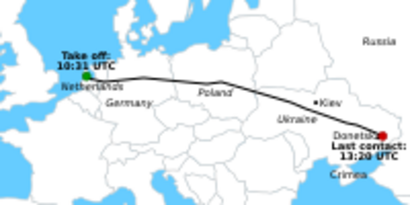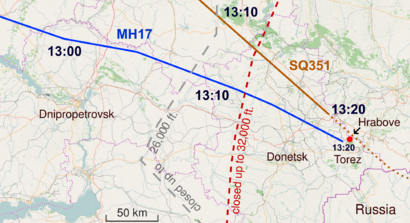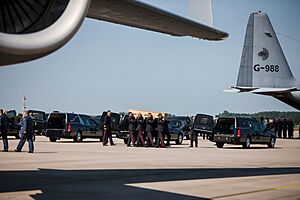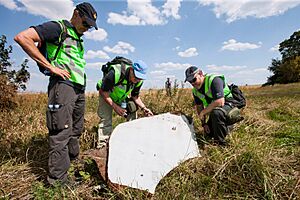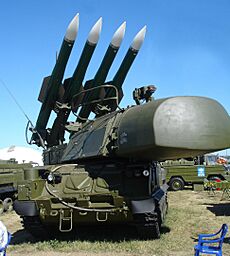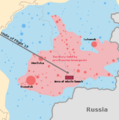Malaysia Airlines Flight 17 facts for kids
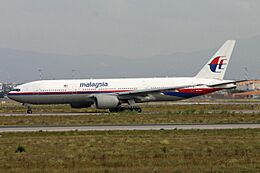
9M-MRD, the aircraft involved, seen in 2011
|
|
| Shootdown summary | |
|---|---|
| Date | 17 July 2014; 11 years, 5 months ago |
| Summary | Shot down by a Buk 9M38 surface-to-air missile transported from Russia on the day of the crash |
| Place | Near Hrabove, Donetsk Oblast, Ukraine 48°08′18.1″N 38°38′21.3″E / 48.138361°N 38.639250°E |
| Passengers | 283 |
| Crew | 15 |
| Fatalities | 298 |
| Survivors | 0 |
| Aircraft type | Boeing 777-200ER |
| Airline/user | Malaysia Airlines |
| Registration | 9M-MRD |
| Flew from | Amsterdam Airport Schiphol, Netherlands |
| Flying to | Kuala Lumpur International Airport, Malaysia |
Malaysia Airlines Flight 17 (MH17) was a passenger plane flying from Amsterdam to Kuala Lumpur. On 17 July 2014, it was shot down over eastern Ukraine. All 283 passengers and 15 crew members on board died.
The plane, a Boeing 777-200ER, lost contact when it was about 50 kilometers (31 miles) from the Ukraine–Russia border. Pieces of the plane fell near Hrabove in Donetsk Oblast, Ukraine. This area was controlled by Russian separatist forces during the war in Donbas.
Investigators from the Dutch Safety Board (DSB) and a special team (JIT) found that a Buk missile shot down the plane. This missile was launched from an area in Ukraine controlled by pro-Russian separatists. The JIT also found that the Buk missile system came from the 53rd Anti-Aircraft Missile Brigade of the Russian Federation. It was brought from Russia on the day of the crash and returned to Russia afterwards.
The governments of the Netherlands and Australia believe Russia is responsible for the missile system. Russia has denied any involvement. In November 2022, a Dutch court found two Russians and a Ukrainian separatist guilty of murder in connection with the crash. The court also said that Russia was in control of the separatist forces at that time.
This event was the second plane loss for Malaysia Airlines in 2014, after Flight 370 disappeared four months earlier. It is the deadliest plane shoot-down incident ever.
Contents
The Aircraft
Flight 17 was a Boeing 777-2H6ER aircraft, registered as 9M-MRD. It was 17 years old on the day of the incident, having first flown on 17 July 1997. The plane was powered by two Rolls-Royce Trent 892 engines. It had flown over 76,300 hours before the crash. The aircraft was in good condition when it left Amsterdam.
The Boeing 777 is known for being a very safe commercial aircraft.
Passengers and Crew
All 283 passengers and 15 crew members on Flight 17 died. The crew members were all Malaysian. Most of the passengers were from the Netherlands (193 people). Other passengers were from Malaysia, Australia, and seven other countries.
| Nation | Number |
|---|---|
| Australia | 27 |
| Belgium | 4 |
| Canada | 1 |
| Germany | 4 |
| Indonesia | 12 |
| Malaysia | 43 |
| Netherlands | 193 |
| New Zealand | 1 |
| Philippines | 3 |
| United Kingdom | 10 |
| Total | 298 |
Among the passengers were some people heading to the 20th International AIDS Conference in Melbourne. This included Joep Lange, a former president of the International AIDS Society. At least twenty families were on the flight, and eighty passengers were under 18 years old.
The flight crew included captains Wan Amran Wan Hussin and Eugene Choo Jin Leong, and first officers Ahmad Hakimi Hanapi and Muhamad Firdaus Abdul Rahim. They all had thousands of hours of flight experience.
Background to the Incident
The armed conflict in Eastern Ukraine had been going on for some months. Because of safety worries, some airlines had already started to avoid flying over eastern Ukrainian airspace.
Reports before July 17 said that rebels fighting the Ukrainian government had weapons, including surface-to-air missiles. On 29 June, Russian news agencies reported that rebels had taken a Buk missile system. The Donetsk People's Republic even claimed to have one on Twitter, though the tweet was later deleted.
These air defense systems cannot easily tell the difference between military and civilian planes. Ukrainian authorities had said that their own Buk systems were not working. However, the Security Service of Ukraine later stated that three Buk missile systems were in rebel-controlled areas when MH17 was shot down. After the crash, two Buk launcher vehicles were seen moving into Russia.
Several Ukrainian military planes had been shot down in the months before MH17. For example, on 14 June 2014, a Ukrainian military transport plane was shot down, killing 49 people. On 14 July, another Ukrainian transport plane was shot down. Rebels claimed they used a Buk missile launcher they had captured.
On 17 July, a journalist saw a Buk launcher in Snizhne, Ukraine, near the crash site. The reporter said the Buk M-1 was operated by a man with a "distinctive Russian accent."
The International Civil Aviation Organization had warned governments about risks to flights over southeastern Ukraine. The American Federal Aviation Administration also advised caution over some parts of Ukraine. However, this warning did not include the area where MH17 crashed. Many airlines continued to fly over eastern Ukraine.
Ukraine managed the airspace above Donetsk. They had restrictions for flights below 32,000 feet (9,800 m) but did not close the airspace completely. Countries often get fees from airlines flying through their territory. This might have played a role in keeping the civilian flight paths open.
Flight and Shoot-Down
On Thursday, 17 July 2014, Malaysia Airlines Flight 17 left Amsterdam Airport Schiphol at 12:13 PM local time. It was supposed to arrive in Kuala Lumpur International Airport the next morning.
Flight Path
MH17 was planned to fly over Ukraine at 33,000 feet (10,060 meters). When it reached the area near Dnipropetrovsk, air traffic control asked if it could climb higher to avoid another plane. The crew chose to stay at 33,000 feet. Later, the crew asked to move a bit north because of bad weather, which was approved. They then asked to climb higher, but this was not possible.
At 4:19 PM local time, air traffic control noticed the plane was slightly off its path and told it to return. Air traffic control then tried to hand over the flight to Russian air traffic control, but the plane did not respond. It had disappeared from radar.
The Missile Strike
The plane's flight recorders stopped working at 4:20:03 PM local time. The last data showed the plane was at 32,998 feet. The recorders showed no warnings before they stopped. However, two loud sounds were heard in the last moments of the cockpit voice recording.
At 4:20:03 PM local time, a Buk missile exploded outside the plane. It hit just above and to the left of the cockpit. The explosion and missile fragments severely damaged the cockpit. The three crew members inside died instantly. The plane broke apart in the air. The front part of the plane tore into pieces, and the middle and back sections also broke apart. This caused the cabin to lose pressure quickly.
The plane fell rapidly and continued to break apart before hitting the ground. The pieces of the plane landed in six different areas. Most of the wreckage, including the middle and rear sections, landed near Hrabove. The debris spread over a large area of 50 square kilometers (19 square miles).
Nearby Aircraft
Three other commercial planes were in the same area when MH17 was shot down. The closest one, Singapore Airlines Flight 351, was about 33 kilometers (21 miles) away.
Recovering the Victims
Ukrainian officials said that bodies found at the crash site would be taken to Kharkiv for identification. By the day after the crash, 181 of the 298 bodies had been found.
On 20 July, Ukrainian emergency workers, watched by armed pro-Russian separatists, began loading the remains onto refrigerated trains. These trains were to take the bodies to Kharkiv. On 21 July, rebels allowed Dutch investigators to examine the bodies.
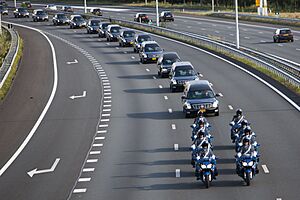
The first remains were flown to Eindhoven in the Netherlands on 23 July. They were transported by Dutch and Australian military planes. The identification of the bodies took place at a facility in Hilversum, coordinated by a Dutch forensic team.
By December 2014, 292 of the 298 victims had been identified. In 2015, more remains were found. Only two victims, both Dutch citizens, remained unidentified.
Aftermath of the Tragedy
About 90 minutes after the incident, Ukraine closed all flight routes in Eastern Ukrainian airspace. This event made people very worried about planes being shot down, and some airlines decided to avoid flying over conflict zones.
Malaysia Airlines stopped using flight number MH17. The Amsterdam–Kuala Lumpur route was changed to flight number MH19 starting on 25 July 2014. The airline later stopped flying to Amsterdam in 2016.
In July 2015, Malaysia suggested that the United Nations Security Council create a special court to prosecute those responsible. Eleven of the fifteen council members supported this idea, but Russia used its veto power to block it.
The Investigation
Two main investigations were led by the Netherlands: one looked into the technical reasons for the crash, and another was a criminal investigation. Ukraine delegated the leadership of both investigations to the Netherlands.
On-Site Work
Soon after the crash, rebels who controlled the crash area promised to allow safe access for investigators. However, for the first two days, they prevented monitors from working freely.
By 18 July 2014, separatists had found the plane's flight data recorder and cockpit voice recorder. They handed them over to Malaysian officials a few days later. The voice recorder was damaged, but its data had not been changed.
An international team, including experts from Malaysia, Australia, and the UK, began working at the crash site in late July. They were led by the Dutch Ministry of Defence. In mid-November 2014, parts of the wreckage were removed from the site. This debris was taken to the Netherlands to help investigators reconstruct parts of the aircraft.
What Caused the Crash?
Soon after the crash, American and Ukrainian officials said a 9M38 series surface-to-air missile was the most likely cause. This type of missile is fired from a mobile Soviet-designed Buk missile system. At the time, the Buk was the only missile system in the region that could reach the plane's high altitude. These systems often cannot tell the difference between military and civilian aircraft.
Damage to the plane's parts showed that small, fast fragments hit the aircraft from outside. This pattern is typical of a Buk missile.
After the crash, a separatist leader, Igor Girkin, was reported to have claimed on social media that they shot down a Ukrainian military plane. Russian news also reported this. However, when it became clear it was a civilian plane, separatists denied responsibility.
Witnesses in the town of Torez saw a Buk missile launcher on the day of the incident. Journalists also reported seeing a Buk system in separatist-controlled Snizhne. These reports matched photos and videos of the launcher in rebel-held territory.
Ukrainian officials stated they had evidence that the missile system was operated by Russian citizens and was moved back into Russia after the attack.
Official Reports
Preliminary Report
On 9 September 2014, the Dutch Safety Board (DSB) released its first report. It said there was no sign of technical problems with the plane or its crew before the recorders stopped. The damage to the front of the plane showed it was hit by many fast objects from outside. This damage likely caused the plane to break apart in the air.
The DSB chairman said the investigation pointed to an "external cause" for the crash.
Final Report
The DSB released its final report on 13 October 2015. It concluded that a Buk 9M38-series surface-to-air missile caused the crash. The missile's warhead exploded outside and above the left side of the cockpit. Fragments from the explosion killed the three people in the cockpit and damaged the plane, causing it to break apart. All 298 people on board died.
The investigators ruled out other causes like meteor strikes, technical problems with the plane, a bomb, or an air-to-air attack. They determined the missile was fired from an area southeast of Torez, which was controlled by pro-Russian separatists.
The report also looked at the flight route. Some airlines had avoided eastern Ukrainian airspace, but many others continued to fly there. The DSB believed Ukrainian authorities should have closed the airspace due to the conflict and earlier military shootdowns.
Legal Cases
In July 2015, families of 18 victims sued the separatist leader Igor Girkin and the Russian government in an American court. They claimed Russia was involved in the act. In May 2016, families of 33 victims also filed a claim against Russia and President Vladimir Putin in the European Court of Human Rights. They argued that Russia's actions violated the passengers' right to life. The Dutch government supported this claim in July 2020. In January 2023, the European Court of Human Rights found that Russia had "effective control" over the areas in eastern Ukraine where the missile was launched.
Reactions to the Crash
Countries Respond
Ukrainian President Petro Poroshenko called the crash an act of terrorism and asked for an international investigation.
Malaysian Prime Minister Najib Razak said that if the plane was shot down, those responsible should be punished. The Malaysian government flew its flag at half-mast for several days.

Dutch Prime Minister Mark Rutte and King Willem-Alexander expressed their shock. The Netherlands opened a war crimes investigation. Dutch government buildings flew flags at half-mast.
Australian Prime Minister Tony Abbott said the plane was shot down by Russian-backed rebels using Russian-supplied equipment. He criticized the recovery efforts at the crash site.
Russian President Putin said Ukraine was responsible because the incident happened in its territory during a conflict.
United States President Barack Obama said the US would help find the cause. US officials called for a ceasefire in Ukraine to allow a full investigation.
Organizations Respond
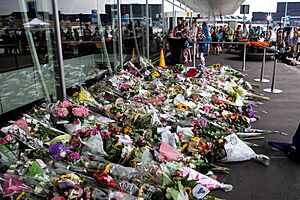
The European Union called for an immediate investigation. The International Civil Aviation Organization sent experts to help. The United Nations Security Council passed a resolution calling for an official crime investigation.
Memorials
Memorial services were held in Australia and the Netherlands. The Netherlands declared 23 July a national day of mourning. The opening of the AIDS 2014 conference, which some victims were traveling to, began with a tribute.
On 17 July 2017, three years after the crash, a memorial was unveiled in Vijfhuizen, the Netherlands. It is located near Schiphol Airport and includes 298 trees, one for each victim.
Russian Media Coverage
Russian media coverage of the crash has been different from most other countries. It has changed over time, often in response to new evidence from investigators. Polls showed that many Russians believed the Ukrainian military caused the crash.
Initial Reports
On the evening of the crash, some Russian news outlets reported that separatists had shot down a Ukrainian military transport plane. However, when it became clear it was a civilian aircraft, separatist media denied responsibility.
Claims of Ukrainian Involvement
For about a year after the crash, Russian state media claimed that a Ukrainian Air Force Su-25 jet shot down Flight 17. They even showed a satellite photo that supposedly proved this, but it was later found to be fake. The Su-25 is a ground attack aircraft and cannot fly as high or as fast as a Boeing 777. Experts and investigators have dismissed this claim as false.
Later, Russian media claimed that a Ukrainian Buk missile system shot down the plane. They suggested the missile was fired from a different location than what investigators found. However, investigators found inaccuracies in these claims.
Conspiracy Theories
Some Russian pro-government media spread other theories. These included claims that Ukrainians shot down the plane by mistake, or that Ukrainian air traffic controllers purposely sent the plane over the war zone. These theories grew as investigations pointed more towards the separatists.
Images for kids
See Also
- List of aircraft accidents and incidents resulting in at least 50 fatalities
- List of airliner shootdown incidents


